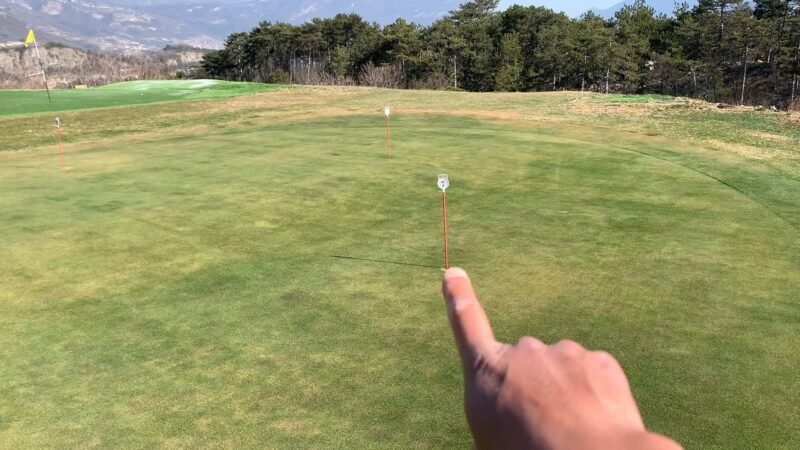Putting is often considered the most critical aspect of the game of golf. It’s the moment when you can sink a crucial putt to win a match or watch as your score slips away. For beginners (including myself), mastering the art of putting can be a daunting task. That’s where Aimpoint Putting comes in.
I often struggle with reading greens effectively and find it challenging to determine the amount of slope or the direction of the break. This always leads me to inconsistent putting and frustration on the course and there goes my day of fun and relaxation.
By learning the fundamentals of Aimpoint Putting, I can gain a solid foundation in understanding slopes, breaks, and aim points, leading to improved accuracy and confidence on the greens. Let’s learn those basics and master this game!
How to Use Aim Point?

1. Feel the Slope With Your Feet
Stand near the midpoint of your putt and try to feel the slope of the green with your feet. You are trying to estimate the amount the green slopes up or down, which will affect the speed and direction of your putt.
2. Assign a Slope Number
The slope of the green is typically represented as a number from 1 to 5, with 1 being a very gentle slope and 5 being a steep slope. This is subjective and comes with practice.
3. Estimate the Direction of the Break
Stand behind the ball looking at the hole and imagine how the slope you felt with your feet would cause the ball to move as it slows down near the hole. This is the “break” of the putt.
4. Use Your Arm to Aim
Once you’ve determined the break, use your arm to aim. Stand facing the hole with your arm extended and your fingers together. Close one eye and line up your fingers with the outside edge of the hole.
Then, move your arm to the left or right to account for the break. The number of fingers you move away from the hole represents the slope number you’ve previously assessed.
5. Adjust Your Aim
Once you have aimed your arm, this should give you the line of the putt. Now it’s time to aim your putt along that line.
6. Hit the Putt
Once you have your line, all you need to do is hit the putt with the right speed.
Basics of Aimpoint Putting
The Concept of Slope and Break
When it comes to putting, the concept of slope and break plays a crucial role. The slope refers to the uphill or downhill tilt of the green, while the break is the sideways movement influenced by the slope.
Understanding these elements is essential for accurately reading greens. Aimpoint Putting emphasizes the importance of recognizing and assessing slopes and breaks to determine the precise aim point for your putt.
The Role of Green Reading
Green reading is a fundamental aspect of Aimpoint Putting. It involves carefully observing and assessing the slope and contour of the green.
This aspect requires attentiveness to details and the ability to recognize subtle variations in break, allowing beginners to navigate the complexities of the putting surface with confidence.
Developing a Solid Setup
To execute this method effectively, players need to establish a solid putting setup. This begins with the proper grip and stance. The grip should be firm but not too tight, allowing for a natural pendulum-like motion during the stroke. The stance should be balanced, with the feet shoulder-width apart and the weight evenly distributed.
This ensures stability and control during the putting stroke. Alignment techniques are also crucial for a consistent setup. Golfers must align their body parallel to the intended target line, ensuring that their shoulders, hips, and feet are all in alignment.
Additionally, aligning the putter face to the target line is essential to start the putt on the correct path.
Mastering the Fundamentals
Aimpoint Putting utilizes the Aimpoint Express system, which simplifies the green reading process. The system provides a predefined aim chart that assigns numbers to different slopes and breaks on the green.
These numbers help golfers quickly determine the aim point based on the distance and severity of the slope. By learning to identify and use the system, amateurs can streamline their green reading process and make accurate adjustments for a successful putt.
Aim Chart
The aim chart is a crucial component in the method. It serves as a reference guide to determine the aim point based on the slope and distance to the hole.
The aim chart provides golfers with a visual representation of how much break to play for a specific putt. In that way, players can gain a deeper understanding of the relationship between slope, break, and aim point. It becomes a valuable tool in making precise calculations and selecting the correct aim point for each putt.
Reading the Green
Reading the green is a skill that every golfer, especially beginners, needs to develop. It involves assessing the slope and contour of the green to determine the aim point.
When reading the green, it’s essential to assess the overall slope of the green, considering uphill, downhill, and side slopes. By observing the contours and nuances of the green, golfers can identify any subtle variations in break that may affect their putts.
Reading the green accurately allows amateurs to make the necessary adjustments and choose the correct aim point, increasing their chances of sinking more putts.
Factors to consider in choosing the correct Aimpoint
Determining the correct Aimpoint requires considering several factors. The severity of the slope is a critical aspect to assess, as it directly affects the amount of break. Steeper slopes will result in more break, while gentler slopes will have less break.
Adjusting for Speed and Distance

Speed and distance are significant factors to consider. The speed of the green affects how much break to play and the pace at which the ball will roll. Faster greens will require golfers to aim further outside the hole to account for the increased break.
On the other hand, slower greens will necessitate less break. The distance to the hole also affects the aim point. Longer putts will have a more significant break, while shorter putts will have less break.
Executing the Putt
Once the aim point has been determined, executing the putt requires a combination of visualizing the line and speed and implementing the proper stroke technique. Visualizing the line and speed of the putt involves creating a mental image of the ball’s path and the desired pace which allows golfers to develop a clear picture of the putt they want to execute.
Implementing the proper stroke technique is equally important. A smooth and controlled stroke, with the putter face kept square to the target line, is crucial for a consistent and accurate putt.
Setting up a Practice Routine

Practicing is key to improving green reading skills and putting performance. Allocate specific practice time for green reading and aim point determination. Head to the practice green and focus on observing and assessing the slopes and contours of various greens.
By incorporating regular practice sessions, you can refine your green reading abilities and gain confidence in selecting the correct aim point for their putts.
Incorporating Aimpoint drills
Aimpoint drills are invaluable for beginners looking to improve their skills. Incorporating drills that utilize the aim chart and focus on reading greens will enhance a golfer’s understanding of slope, break, and aim points.
For example, set up a series of putts with varying distances and slopes, and use the aim chart to determine the aim points. Practice hitting putts to those aim points, focusing on accuracy and consistency.
Another drill could involve reading a green without using the aim chart and then comparing the results to the aim chart’s recommendations.
Common Mistakes to Avoid
Misreading Slope and Break
One common mistake that beginners make is misreading the slope and break of the green. It’s crucial to accurately assess the slope and understand its effect on the break of the putt. Misjudging the slope can lead to incorrect aim points and missed putts.
Beginners should take their time to observe and analyze the slopes carefully, considering both the overall slope and any subtle variations.
Overcompensating for Speed
Another mistake to avoid is overcompensating for speed. It’s important to trust the aim point determined by this method rather than trying to manipulate the speed excessively. Overcompensating can lead to inconsistent results and missed putts.
Troubleshooting and Adjustments

Even with a solid foundation, golfers may encounter situations where misalignment occurs. Correcting for misalignment is crucial to ensure that the putter face is square to the target line.
Taking the time to align the body and putter face correctly before each putt can greatly improve accuracy. Adjusting the setup and making small corrections can prevent misalignment issues and ensure that the putt starts on the intended line.
Modifying Calculations
In certain situations, golfers may need to modify their Aimpoint calculations. Factors such as changing green conditions or variations in green speed may require adjustments to the aim point.
Paying attention to the speed of the green and making subtle modifications to the aim point based on these factors can improve accuracy and increase the chances of sinking putts. It’s essential for amateurs to be adaptable and willing to make adjustments when necessary.
Advanced Tips and Strategies

As golfers become more proficient in Aimpoint Putting, they can explore advanced tips and strategies.
One of these is reading double breaks and complex greens. Some greens may have multiple slopes and breaks that require golfers to make precise calculations and adjustments.
Another advanced tip is adapting to different green speeds. Green speeds can vary from course to course or even within a single round. Adjusting the aim point and stroke speed to account for faster or slower greens is essential for successful putting.
By practicing on greens with varying speeds and learning to make the necessary adaptations, beginners can become more versatile and confident in their Aimpoint Putting skills.
Have you ever wondered how profitable owning a golf course is and what factors account for that calculation?
FAQs:
Can Aimpoint help golfers with their green-reading skills even if they don’t have perfect vision?
Yes, the method relies on the golfer’s sense of feel and perception rather than visual acuity, making it accessible to golfers with varying levels of vision.
Does this method require a lot of mental calculations during a round?
The method encourages golfers to practice and internalize the calculations, so they become more intuitive and less mentally demanding during a round.
Are there any famous professional golfers who use Aimpoint Putting?
Yes, several notable professional golfers, including Adam Scott and Stacy Lewis, have embraced it as part of their putting strategies.
Can it be combined with other putting techniques or styles?
Yes, golfers can integrate Aimpoint with their preferred putting techniques and styles to enhance their overall performance on the greens.
Is Aimpoint legal to use in tournament play?
Yes, it is legal as it involves reading the greens without the use of prohibited devices.
Conclusion
In conclusion, Aimpoint Putting is a game-changing system that provides beginners with a structured approach to reading greens and executing successful putts.
By understanding the basics of the system, developing a solid setup, mastering the fundamentals, and practicing consistently, golfers can improve their green reading abilities and enhance their overall putting skills.
Avoiding common mistakes, troubleshooting when necessary, and exploring advanced tips and strategies will further refine their technique.
So, get out there, practice this method, and watch your putting game soar to new heights. With dedication and perseverance, success on the greens is within your reach!







